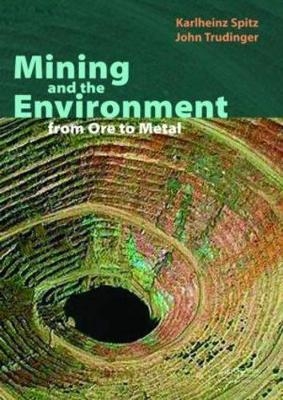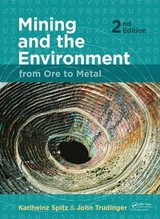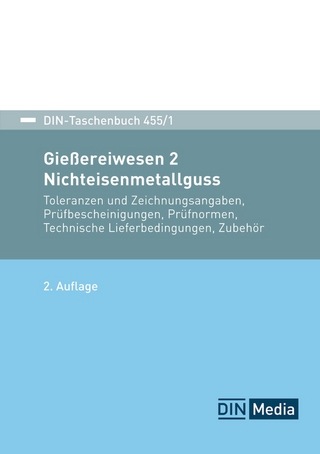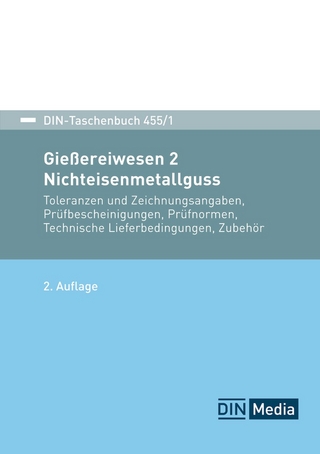
Mining and the Environment
Taylor & Francis Ltd (Verlag)
978-0-415-46509-0 (ISBN)
- Titel erscheint in neuer Auflage
- Artikel merken
The history of mining is replete with controversy, much of it relating to environmental damage and consequent community outrage. Over recent decades there has been increasing pressure to improve the environmental and social performance of mining operations, particularly in developing countries. The industry has responded by embracing the ideals of corporate social responsibility.
This book identifies and discusses the wide range of social and environmental issues pertaining to mining, with particular reference to mining in developing countries from where many of the project examples and case studies have been selected. Following an introductory overview of the issues of concern, the book illustrates how environmental impact assessment as defined in "The Equator Principles", integrates with the mining lifecycle, and how environmental assessment aims to eliminate the negative and to accentuate the positive mining impacts. The text illustrates the wide range of environmental and social concerns and opportunities. Practical approaches are provided to manage issues ranging from land acquisition and resettlement or indigenous peoples issues, through the technical aspects of acid rock drainage and mine waste management, to a thorough analysis of ways and means of sharing mining benefits with host communities so that these benefits are not transitory, allowing mining to become a sustainable economic activity.
The wide coverage of issues raised illustrated by many real-life case studies, makes this practice-oriented book a reference and key reading for operators in the field, as well as for environmental consultants, regulators, and students. This book will also be of interest to environmental personnel in the oil & gas industry as much of the subject matter applies to the extractive industries as a whole.
Dr. Karlheinz Spitz is an environmental consultant with more than 20 years professional experience in Canada, Europe, Asia, and Australia. His main interest is the environmental assessment of large resource development projects in developing countries. He worked on many mines in South East Asia, covering a wide range of minerals and a diverse spectrum of environmental and social settings. Dr. Spitz understands mining as a sustainable economic activity; his focus is on the social, economic and environmental performance of mining. Dr. Spitz provides high level advice to Equator Principles Financial Institutions, and he is regular guest lecturer at various universities. John Trudinger is an environmental consultant with more than 40 years of professional experience. Initially qualified as a geologist, his initial experience was on geotechnical investigations for large infrastructure projects. In the early 1970’s he became involved in the emerging environmental business, and has since contributed as team member or team leader on environmental assessments for more than 100 resource development and infrastructure projects. He has worked throughout Australia, Asia and North America. His particular interest is the management of mine wastes in the mountainous wet tropics.
1. MINERALS, WEALTH AND PROGRESS
History of Mining
The Path of Minerals from Cradle to Grave
Minerals – A Natural Resource Blessing?
What Makes the Mining Industry Different?
The Unique Risk Profile of Mining
Meeting Environmental Issues Head On
Environmental Assessment Practice – Eliminate the Negative, Accentuate the Positive
The Equator Principles – Improved Practices for Better Outcomes
Caring for Future Generations
2. ENVIRONMENTAL IMPACT ASSESSMENT
Protection before Exploration
Mining Companies are not Governments
Environmental Assessment in the Mining Cycle
Managing the Environmental Impact Assessment Process
Common Themes and Core Principles
When is an EIA Required?
Environmental Impact Assessment Step-by-Step
Documenting the Findings
Obtaining EIA Approval
The Costs of Delay
Environmental Management and Monitoring is Important
Planning for Mine Closure
What Environmental Impact Assessment is Not
3. INVOLVING THE PUBLIC
Forging Partnerships and Trust
Historical Perspective
Planning Stakeholder Involvement
Getting To Know Your Stakeholders
How to Identify Stakeholders?
Engaging Stakeholders
Conflict Identification and Management
Understanding the Benefits and Risks of Public Involvement
Who Guards the Guardians?
Common Mistakes
4. THE ANATOMY OF A MINE
It All Begins in the Earth
Exploration – From Reviewing Data to Taking Bulk Samples
Feasibility - Is it Worth Mining?
Engineering, Procurement, and Construction
Mining
Mine Waste Disposal
Ancillary Facilities
Design for Mine Closure
Artisanal Mining – Mining Outside of Established Laws
5. MINING METHODS VARY WIDELY
Mining Methods
Ferrous metals and ferroalloys
Non-ferrous ores
Industrial Minerals
Mineral (Fossil) Fuels
Gemstones
6. CONVERTING MINERALS TO METALS
Beneficiation – Using Basic Physics
Pyro metallurgy – The Use of Fire
Hydrometallurgical Mineral Processing – Essentially Chemical Processing
Refining
7. OUR ENVIRONMENT
A Set of Natural and Human Features
The Atmosphere - Air, Weather, and Climate
The Lithosphere – Geology, Land Form, and Earth Resources
The Hydrosphere – Storage and Movement of Water
The Biosphere – Life on Earth
The Social Sphere – Social and Cultural Fabric of Society
The Economic Sphere – Production, Distribution, and Consumption of Goods and Services
Judging State and Value of the Environment
What are Nature’s Economic Values?
International Laws Pertaining to Natural and Environmental Resources
8. THE BASELINE
Understanding the Host Environment
The Importance of Conflict Identification
The Use of Indicators
Environmental Scoping
Conducting Baseline Surveys –Ways and Means
Converting Data to Information
The Use of Remote Sensing Techniques and Geographic Information Systems
9. IDENTIFYING AND EVALUATING IMPACTS
Working within Limitations
Deciding on a Direction
Deciding on the Methodologies
Linking Cause and Effect
Identifying Project Impacts
Evaluating Environmental Change
Cultural Heritage
The Special Nature of Community Impacts
Do People Count? – The Concept of Environmental Justice
Group Decision-Making in Environmental Assessment
Reflecting on the Objective Nature of Environmental Assessment
Dealing with Uncertainties and Risks
10. EMPHASIZING ENVIRONMENTAL MANAGEMENT AND MONITORING
Managing what Matters
Measure to Manage
Environmental Management Systems
Commitment, Funds and Resources
11. METALS, THEIR BIOLOGICAL FUNCTIONS AND HARMFUL IMPACTS
Persistence, Bioaccumulation and Toxicity of Metals
Selected Metals
12. Was The Environmental Assessment Adequate?
Reviewing an Environmental Impact Assessment
Environmental Mine Auditing
Thinking Outside of the Box
Responding to Unforeseen Occurrences
13. THE RANGE OF ENVIRONMENTAL CONCERNS
Physical Impacts from Mine Structures and Waste Management Units
Mine wastes
Mine Site Effluent Streams
Biodiversity and Habitats
Social Change
Mining and Climate Change
Surface Mining versus Underground Mining
Accidental Impacts
14. LAND ACQUISITION AND RESETTLEMENT
When Property and Development Rights Collide
Some Useful Definitions
Compensation- A Right, Not a Need
Resettlement Priorities
Accounting Resettlement Losses
The Social Risks of Resettlement
What Determines the Severity of Resettlement Losses?
Estimating the Significance of Resettlement
Managing Resettlement
Common Issues around Resettlement
15. COMMUNITY DEVELOPMENT
Ensuring Long term Benefits
What Defines a Community?
Pointers to Success
Community Development Process
Preparing for Mine Closure
Community Programs – What to Do?
Local Benefits Do Not Always Follow
Common Problems and Solutions
16. INDIGENOUS PEOPLES ISSUES
Some Basic Considerations
Issues and Opportunities
Strategies for Interaction with Indigenous Communities
Preserving or Restoring Autonomy
Sharing Benefits
Monitoring Effectiveness of Programs
17. ACID ROCK DRAINAGE
The Unseen Legacy
Nature and Significance of Acid Rock Drainage
Effects of Acid Rock Drainage
Evaluating the Occurrence or Risk of ARD
Assessing Potential for ARD
ARD Controls
18. TAILINGS DISPOSAL CONCEPTS AND PRACTICES
Deciding on the Tailings Disposal Scheme
Alternative Approaches to Tailings Disposal
Surface Tailings Storage
Submarine Tailings Placement
19. APPROACHES TO WASTE ROCK DISPOSAL
Nature and Characteristics of Waste Rock
Design of Waste Rock Disposal
Potential Impacts of Waste Rock Disposal
Monitoring
20. EROSION – The Perpetual Disruptive Force of Water and Wind
The Disruptive Force of Water
Five Contributing Factors
Managing Water Erosion
Fugitive Emissions by Wind
21. MINE CLOSURE - It is not over when it is over
Principle Guidance
Financing Mine Closure
Objectives
Soil Preparation
Establishment of Vegetation
Progressive Rehabilitation versus Post-Closure Rehabilitation
Acceptance Criteria and Sustainability
22. EXISTING TRENDS
Existing Trends in the Mining Sector
Mining Company, Financial Institutions, Government, and Public (NGO) – All Have to Contribute
Strength and Weaknesses of Mining Companies – Size Matters
Mining in the Last Frontiers
Solutions Can Be Developed for Each Challenge
| Erscheint lt. Verlag | 26.11.2008 |
|---|---|
| Verlagsort | London |
| Sprache | englisch |
| Maße | 219 x 276 mm |
| Gewicht | 2336 g |
| Themenwelt | Technik ► Bergbau |
| ISBN-10 | 0-415-46509-5 / 0415465095 |
| ISBN-13 | 978-0-415-46509-0 / 9780415465090 |
| Zustand | Neuware |
| Informationen gemäß Produktsicherheitsverordnung (GPSR) | |
| Haben Sie eine Frage zum Produkt? |
aus dem Bereich



